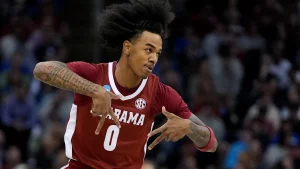
The Indiana Fever organization and their fans find themselves on edge, facing a troubling possibility surrounding one of the brightest young stars in women’s basketball, Caitlin Clark. Clark, a dazzling talent whose electrifying play has captivated audiences across the nation, has recently been sidelined by an injury that has sparked concern within the Fever’s camp about her long-term health and career longevity. While many in the basketball world hold great hope for Clark’s future, whispers of lingering physical issues have stirred fears that her promising trajectory could be compromised.
Caitlin Clark’s rise in the basketball world has been nothing short of meteoric. Since her college days at Iowa, Clark has been a force to be reckoned with — combining remarkable shooting range, sharp court vision, and a competitive fire that fuels her relentless pursuit of excellence. Her transition to the WNBA, and specifically the Indiana Fever, was greeted with excitement and high expectations, as fans and analysts alike anticipated that she would be a franchise cornerstone and a player capable of reshaping the league’s landscape.
Unfortunately, the physical demands of professional basketball, especially for a player as active and aggressive as Clark, can sometimes take a heavy toll. Over the past several weeks, Clark has been nursing an injury that, while initially viewed as minor, has persisted longer than anyone expected. This delay in recovery has raised red flags for Fever medical staff, coaches, and fans alike, who now fear that the injury could have lingering effects that extend well beyond the current season.
The exact nature of Clark’s injury has been kept relatively private, adding an element of speculation and concern. What is known is that it involves a critical joint — one integral to her movement, agility, and shooting mechanics. This injury is the kind that, if not fully healed, can significantly alter a player’s performance, potentially diminishing the sharpness and explosiveness that Clark relies on to dominate her opponents. Moreover, the risk of aggravating the injury could force Clark to modify her playing style in ways that might limit her effectiveness and put undue stress on other parts of her body.
For an athlete like Clark, whose game is built on precision and athleticism, any physical limitation is cause for concern. The Indiana Fever have built their strategy around Clark’s unique skill set, and any extended absence or reduction in her abilities could have a ripple effect on the team’s competitiveness. The Fever, who are already navigating a challenging rebuild, count on Clark not just as a scorer but as a leader and inspiration to younger teammates. Her presence on the court energizes the team and drives fan engagement, making the stakes around her health all the more critical.
Beyond the immediate basketball implications, there is a broader worry about Clark’s long-term career prospects. Injuries of this nature, if not managed carefully, can evolve into chronic problems that shorten careers or lead to repeated layoffs. History is replete with examples of athletes whose careers were curtailed or never fully realized due to lingering physical setbacks. The mental and emotional toll of ongoing injury struggles can be just as damaging as the physical pain, affecting confidence and motivation.
In Clark’s case, the stakes feel even higher given her status as one of the most marketable and recognizable faces in the WNBA. Her story is not just about athletic prowess but also about the growing visibility and prominence of women’s basketball. Fans see her as a role model and a symbol of the sport’s potential. As such, there is a shared desire — among teammates, coaches, and the wider basketball community — to protect her from long-term harm and ensure that she enjoys a full, healthy, and successful career.
The Fever’s medical and coaching staff have reportedly been working closely with Clark to monitor her recovery, employing advanced treatment protocols and cautious training regimens designed to facilitate healing without rushing her back prematurely. This approach is wise but inevitably frustrating for a competitor of Clark’s caliber, who thrives on being in the thick of the action and contributing at the highest level. Patience is difficult when the natural instinct is to fight through adversity and keep pushing forward.
Adding to the challenge is the fierce competition in the WNBA, where every team is loaded with talent and the margin for error is razor-thin. Sitting out games or playing at less than 100% can translate to lost opportunities and dropped games, impacting team standings and playoff chances. For the Fever, who are eager to make a statement in the league, the uncertainty around Clark’s availability and effectiveness poses a strategic dilemma.
Meanwhile, the fans have been vocal in their support, sending messages of encouragement and hope. Social media platforms have been flooded with well-wishes for Clark’s speedy and complete recovery. The Fever’s community understands the delicate balance between urgency and caution in managing such an injury. They want Clark back on the court, doing what she does best — thrilling crowds with her shooting brilliance and court leadership — but they also want her to be fully healthy so that she can sustain her career over many seasons.
This injury situation also shines a spotlight on the broader issue of athlete health and wellness in professional women’s basketball. The physical demands on players continue to escalate, with more games, longer seasons, and increased expectations. Teams and leagues are investing in better medical resources and recovery technologies, but the risk of injury remains a constant threat. Stories like Clark’s remind us of the fragility of athletic careers and the importance of supporting players holistically — physically, mentally, and emotionally.
In addition, this scenario underscores the necessity for realistic expectations in professional sports. While fans often want to see their stars perform every night at peak levels, the reality is that recovery and rehabilitation are complex processes that don’t always follow neat timelines. Rushing back too soon can cause setbacks, while patience can sometimes mean temporary frustration but long-term benefit. How the Fever manage this situation may well influence how other teams handle similar cases in the future.
Looking ahead, the key questions remain: Will Caitlin Clark be able to fully recover and return to the form that made her a standout star? Can the Fever build a competitive team around her that can weather the uncertainty and emerge stronger? And most importantly, can Clark’s career be safeguarded so that she continues to inspire and lead the next generation of basketball players?
There is cautious optimism that with proper care, Clark can overcome this hurdle. Her work ethic, determination, and access to top-tier medical support are significant assets. However, the lingering nature of the injury cannot be ignored, and the Fever will need to remain vigilant and flexible, ready to adjust plans as needed to prioritize her health above all else.
In the meantime, this unfolding situation serves as a reminder of the human side of sports — that behind every highlight reel and dazzling play is an athlete facing physical and mental challenges. It’s a call for empathy and patience from fans and a challenge for teams to balance competitiveness with compassion.
For the Indiana Fever, Caitlin Clark represents more than just a player; she is the heart of their franchise’s future and a beacon for the sport’s growth. Protecting that future is paramount, even if it means confronting tough decisions and navigating uncertainty. The road ahead may have obstacles, but with careful management and unwavering support, there is hope that Clark’s injury will become a temporary setback rather than a career-defining crisis.
As the Fever and their star work through this difficult chapter, the basketball community watches closely, holding their collective breath, hoping for the best but bracing for the reality that sometimes the greatest victories come not from triumphs on the scoreboard, but from resilience in the face of adversity.





